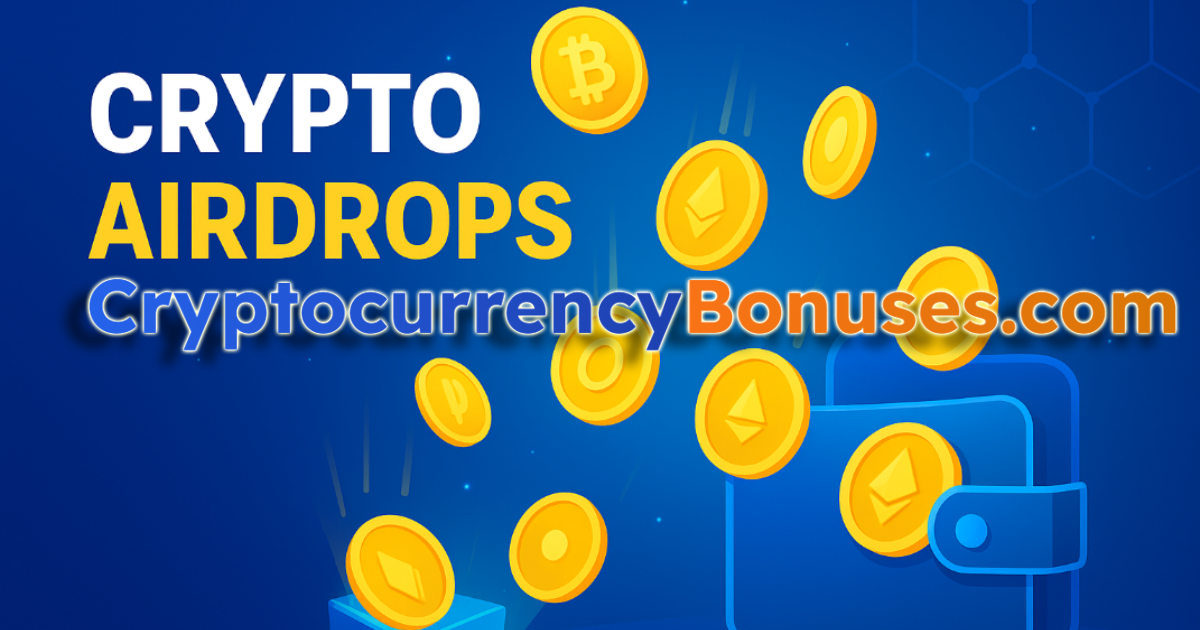Introduction to Airdrops
One of the most exciting ways to enter the cryptocurrency world is through airdrops. These are free token distributions carried out by blockchain projects as a way to raise awareness, attract new users, or reward loyal community members.
Unlike traditional investment strategies, airdrops don’t require you to spend money upfront. Instead, they allow you to collect tokens simply by being an active participant—whether that means signing up for a project, completing small tasks, or holding a certain cryptocurrency in your wallet.
At cryptocurrencybonuses.com, we track not only crypto bonuses and gambling promotions but also trends like airdrops that give enthusiasts new opportunities to grow their portfolios.
What is a Crypto Airdrop?
A crypto airdrop is a marketing and distribution strategy used by blockchain projects. Instead of selling all their tokens in an initial coin offering (ICO) or listing them directly on exchanges, projects distribute some tokens for free to early adopters or loyal supporters.
Airdrops serve two main purposes:
- Promotion – By giving away free tokens, projects generate buzz and encourage people to talk about their platform.
- Decentralization – Distributing tokens widely ensures that no single entity holds too much control, making the project more community-driven.
Types of Airdrops
Not all airdrops are the same. Here are the most common types you’ll encounter:
1. Standard Airdrops
These are the simplest form of distribution. Users sign up with their wallet address, and tokens are sent automatically once the airdrop campaign ends.
Example: Early projects like Stellar (XLM) distributed millions of tokens through simple sign-ups to grow awareness.
2. Holder Airdrops
Sometimes called “loyalty airdrops,” these are given to users who already hold a specific cryptocurrency.
Example: Uniswap (UNI) famously rewarded anyone who had used its exchange before a certain date with 400 UNI tokens—worth thousands of dollars at the time.
3. Task-Based Airdrops
Participants complete certain tasks to qualify, such as joining a Telegram group, following on Twitter, or sharing posts.
Example: Many smaller DeFi projects run social media-based airdrops to build community engagement quickly.
4. Exclusive or Private Airdrops
Reserved for early investors, NFT holders, or community members who contribute significantly to a project.
Example: Some gaming and NFT platforms distribute special tokens only to those who purchased early editions of their assets.
How to Get Airdrops
Participating in airdrops is usually straightforward, but being consistent and careful is key. Here are the most common ways to qualify:
- Join Official Communities: Follow projects on Twitter, Discord, and Telegram. Many announce airdrops to their followers first.
- Register Your Wallet: Sign up on official websites and provide a compatible wallet address, usually Ethereum, Solana or Binance Smart Chain.
- Complete Social Tasks: Like, share, retweet, or tag friends on social media campaigns.
- Hold Eligible Tokens: Keep specific coins in your wallet before a snapshot date.
- Stay Active on dApps: Some platforms reward users who test their services before launch, like decentralized exchanges or NFT marketplaces.
Examples of Famous Airdrops
Crypto history is full of legendary airdrops that turned early adopters into big winners:
- Uniswap (UNI): Every wallet that interacted with Uniswap before September 2020 received 400 UNI tokens. At peak value, this was worth over $12,000.
- Ethereum Name Service (ENS): Users who registered ENS domains got an airdrop of governance tokens in 2021, leading to thousands of dollars in rewards.
- Stellar (XLM): Distributed billions of tokens in early campaigns to promote adoption, with some users receiving hundreds of dollars for free.
- Aptos (APT): Early testers of the blockchain received generous token distributions that quickly reached significant value once listed.
These cases show how being early and attentive can pay off in surprising ways.
Benefits of Airdrops
- Low Risk: No upfront cost for participants.
- Portfolio Diversification: Exposure to new tokens without buying them.
- Community Growth: Helps projects attract loyal early adopters.
- Potentially Huge Rewards: As history shows, airdrops can be worth thousands if the project succeeds.
Risks and Challenges
While airdrops sound like free money, they’re not without risks:
- Scams & Fake Airdrops: Some campaigns are phishing attempts designed to steal private keys.
- Data Risks: Projects may require email or social accounts, which can lead to spam.
- Uncertain Value: Many tokens never gain traction, meaning your “free” coins may be worth nothing.
- Taxation: In many countries, airdrops are considered taxable income.
To stay safe, never share your private keys, and only participate in airdrops from reputable projects.
How Airdrops Connect to Crypto Gambling and Bonuses
The concept of airdrops isn’t too different from crypto bonuses in gambling. Both are designed to attract users and encourage participation. In fact, some crypto casinos and poker platforms are beginning to use airdrops as part of their promotional strategy, rewarding early players with native tokens that can later be used for betting or traded.
For the latest trends in gambling-related promotions, visit our mainpage Cryptocurrency bonuses where we cover exclusive bonuses, promotions, and news on how crypto is reshaping the gambling industry.
The Future of Airdrops
As the crypto space becomes more regulated, airdrops are also changing. We’re already seeing:
- More Compliance: Some projects now require KYC verification.
- Targeted Airdrops: Tokens may be distributed only to active dApp users rather than anyone signing up.
- Gamified Airdrops: NFTs and play-to-earn projects reward users through interactive events rather than simple token drops.
- Integration with Web3: Expect airdrops to become key onboarding tools in the metaverse and decentralized apps.
Conclusion
Crypto airdrops remain one of the most exciting parts of the blockchain world. They reward early adopters, spread awareness, and can turn small efforts into huge returns. But they also require caution—many projects won’t succeed, and scams are common.
If you’re ready to explore the opportunities that crypto rewards bring—whether through airdrops, bonuses, or promotions—check out cryptocurrency bonuses for the latest updates.
